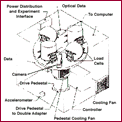



Objectives
LME has it's goal to quantify the dominating influence of liquid propellant motions on spacecraft nutational dynamics; therefore improve the design of control systems. The objectives of LME were: (1) to obtain data in a realistic low-g environment to validate and provide physical guidance for improved analytical models of liquid motions in the tanks of spinning spacecraft and (2) to obtain data in a realistic low-g environment to validate, and improve if necessary, procedures for scaling ground test data from spacecraft physical models to flight conditions.
Shuttle-Mir Missions Approach
LME is essentially a spin table that creates a realistic precession motion of scale-model tanks containing liquid. The table is driven by two independently controllable electric motors; one of the motors provides a steady rotation, and the other provides precession with independently adjustable nutation frequency. The inclination of the spin table (i.e., the cone angle theta) is constant at 5 degrees. Four transparent tanks of two different shapes and fill levels will be tested simultaneously. All tanks are approximately four inches in diameter. Three sets of such tanks will be employed to vary liquid viscosity. Tests were conducted at low spin rates to study the surface tension phenomenon. Test measurements included the liquid torque exerted on the tanks and the phase angle of the torque relative to table motion. Video recordings were made of the liquid motion and free surface waves to aid in model development.
Results Publications Principal Investigators![]()
STS-84
Spacecrafts spin continuously in orbit in order to control the location of liquid propellants in the tanks, distribute solar heat loads, and transfer the maneuver from low Earth orbit to the mission orbit to obtain gyroscopic stiffness. Spinning can cause problems such as inducing a wobble motion characterized by a oscillation in the spin axis; the amplitude of wobble is characterized by the coning angle, theta. This precession (wobble) sets into oscillation the spacecraft's flexible components, and the energy dissipated by the internal friction of these components causes the precession amplitude to increase continually until, the attitude control thrusters must be fired to bring the amplitude back to an acceptable level. In most spacecraft, the most flexible component is the mobile liquid propellent in partially-filled spinning tanks.
The Liquid Motion in a Rotating Tank Experiment was successfully operated in the SpaceHab on STS-84. LME operated during Flight Days 8 and 9. Twenty-five of the 27 tests were successfully completed before the SpaceHab was closed in preparation for landing. Data on the first 9 tests was downlinked to the Payload Operations Communications Center team on Flight Day 9.
None available at this time.
�
Franklin T. Dodge, Ph.D.
Southwest Research Institute
![]()
|
|
Curator:
Julie Oliveaux
Responsible NASA Official: John Uri |
Page last updated: 07/16/1999
.gif)